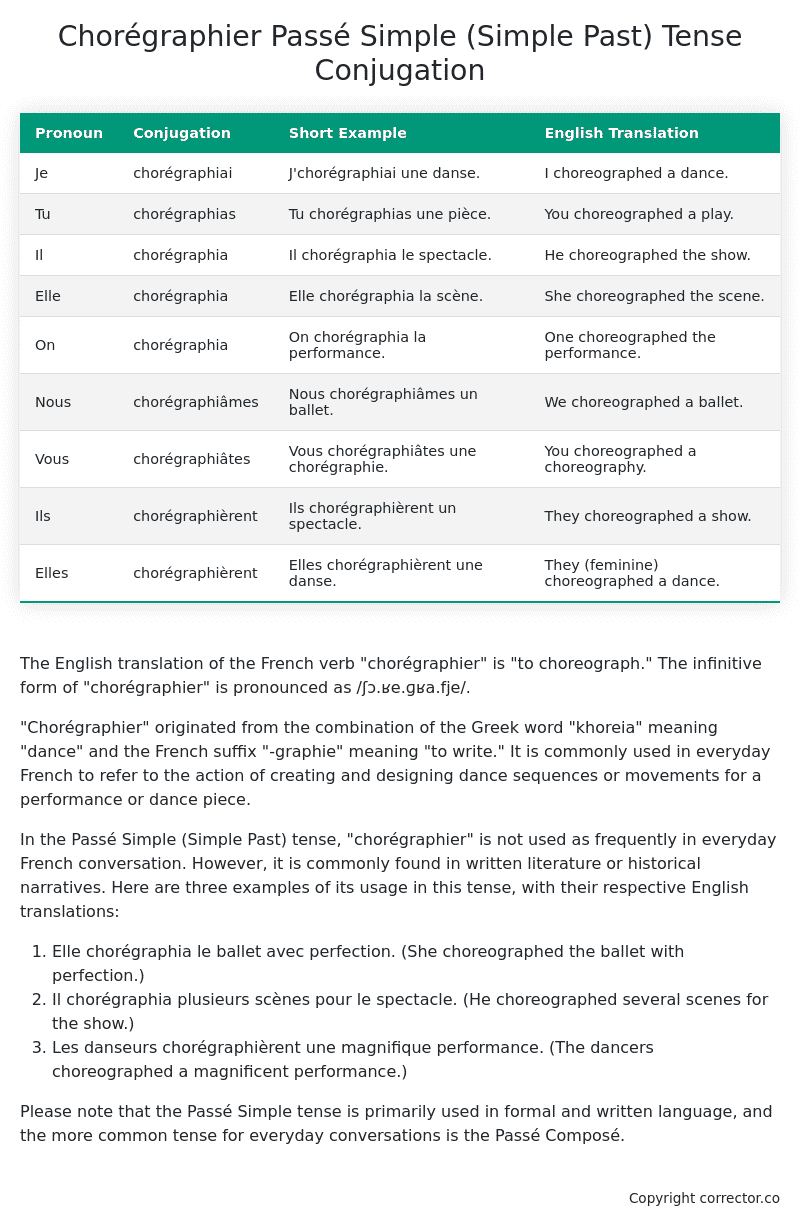Passé Simple (Simple Past) Tense Conjugation of the French Verb chorégraphier
Introduction to the verb chorégraphier
The English translation of the French verb “chorégraphier” is “to choreograph.” The infinitive form of “chorégraphier” is pronounced as /ʃɔ.ʁe.ɡʁa.fje/.
“Chorégraphier” originated from the combination of the Greek word “khoreia” meaning “dance” and the French suffix “-graphie” meaning “to write.” It is commonly used in everyday French to refer to the action of creating and designing dance sequences or movements for a performance or dance piece.
In the Passé Simple (Simple Past) tense, “chorégraphier” is not used as frequently in everyday French conversation. However, it is commonly found in written literature or historical narratives. Here are three examples of its usage in this tense, with their respective English translations:
- Elle chorégraphia le ballet avec perfection. (She choreographed the ballet with perfection.)
- Il chorégraphia plusieurs scènes pour le spectacle. (He choreographed several scenes for the show.)
- Les danseurs chorégraphièrent une magnifique performance. (The dancers choreographed a magnificent performance.)
Please note that the Passé Simple tense is primarily used in formal and written language, and the more common tense for everyday conversations is the Passé Composé.
Table of the Passé Simple (Simple Past) Tense Conjugation of chorégraphier
| Pronoun | Conjugation | Short Example | English Translation |
|---|---|---|---|
| Je | chorégraphiai | J’chorégraphiai une danse. | I choreographed a dance. |
| Tu | chorégraphias | Tu chorégraphias une pièce. | You choreographed a play. |
| Il | chorégraphia | Il chorégraphia le spectacle. | He choreographed the show. |
| Elle | chorégraphia | Elle chorégraphia la scène. | She choreographed the scene. |
| On | chorégraphia | On chorégraphia la performance. | One choreographed the performance. |
| Nous | chorégraphiâmes | Nous chorégraphiâmes un ballet. | We choreographed a ballet. |
| Vous | chorégraphiâtes | Vous chorégraphiâtes une chorégraphie. | You choreographed a choreography. |
| Ils | chorégraphièrent | Ils chorégraphièrent un spectacle. | They choreographed a show. |
| Elles | chorégraphièrent | Elles chorégraphièrent une danse. | They (feminine) choreographed a dance. |
Other Conjugations for Chorégraphier.
Le Present (Present Tense) Conjugation of the French Verb chorégraphier
Imparfait (Imperfect) Tense Conjugation of the French Verb chorégraphier
Passé Simple (Simple Past) Tense Conjugation of the French Verb chorégraphier (You’re reading it right now!)
Passé Composé (Present Perfect) Tense Conjugation of the French Verb chorégraphier
Futur Simple (Simple Future) Tense Conjugation of the French Verb chorégraphier
Futur Proche (Near Future) Tense Conjugation of the French Verb chorégraphier
Plus-que-parfait (Pluperfect) Tense Conjugation of the French Verb chorégraphier
Passé Antérieur (Past Anterior) Tense Conjugation of the French Verb chorégraphier
Futur Antérieur (Future Anterior) Tense Conjugation of the French Verb chorégraphier
Subjonctif Présent (Subjunctive Present) Tense Conjugation of the French Verb chorégraphier
Subjonctif Passé (Subjunctive Past) Tense Conjugation of the French Verb chorégraphier
Subjonctif Imparfait (Subjunctive Imperfect) Tense Conjugation of the French Verb chorégraphier
Conditionnel Présent (Conditional Present) Tense Conjugation of the French Verb chorégraphier
Conditionnel Passé (Conditional Past) Tense Conjugation of the French Verb chorégraphier
Conditionnel Passé II (Conditional Past II) Tense Conjugation of the French Verb chorégraphier
L’impératif Présent (Imperative Present) Tense Conjugation of the French Verb chorégraphier
L’impératif Passé (Imperative Past) Tense Conjugation of the French Verb chorégraphier
L’infinitif Présent (Infinitive Present) Tense Conjugation of the French Verb chorégraphier
L’infinitif Passé (Infinitive Past) Tense Conjugation of the French Verb chorégraphier
Le Participe Présent (Present Participle) Tense Conjugation of the French Verb chorégraphier
Le Participe Passé (Past Participle) Tense Conjugation of the French Verb chorégraphier
Struggling with French verbs or the language in general? Why not use our free French Grammar Checker – no registration required!
Get a FREE Download Study Sheet of this Conjugation 🔥
Simply right click the image below, click “save image” and get your free reference for the chorégraphier Passé Simple tense conjugation!

Chorégraphier – About the French Passé Simple (Simple Past) Tense
Formation
Usage
Narration
Historical Context
Interactions with other tenses
Passé Composé
Imparfait
Conditional and Subjunctive
Summary
I hope you enjoyed this article on the verb chorégraphier. Still in a learning mood? Check out another TOTALLY random French verb conjugation!


